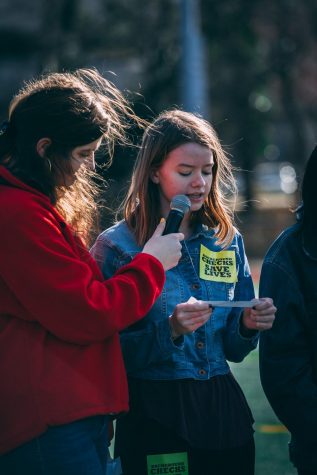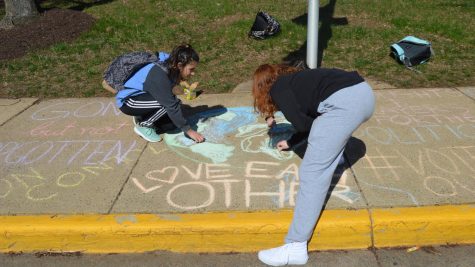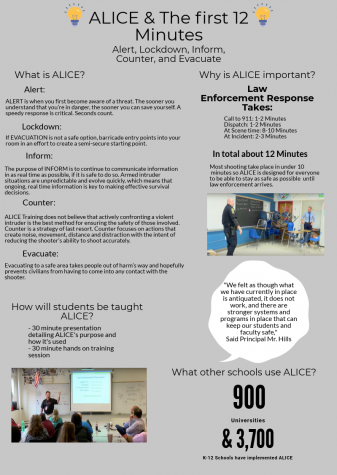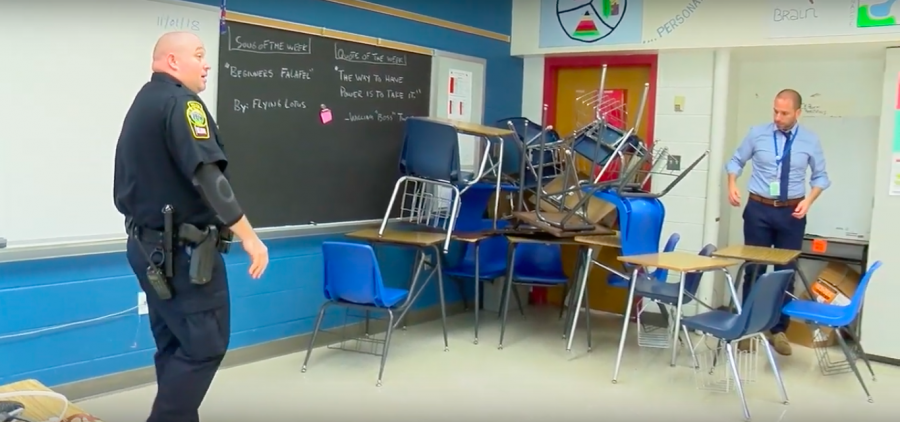GM School Resource Officer Clark Gagnon and Thomas Jefferson Elementary School Assistant Principal Rob Carey participate in hands-on ALICE training. All teachers have been trained to use ALICE, a new way to respond to school shootings, which includes barricading doors, as shown in this picture. (Photo courtesy of Tom Polera).
The First 12 Minutes: surviving school shootings
For years, school shootings have dominated the news. There have been calls for bans on bump stocks, stricter background checks, and more comprehensive mental health resources. After the shooting at Columbine High School in 1999, police revolutionized their response to school shootings, entering the building instead of waiting outside to negotiate with the shooter. But only in the past year have schools begun to prepare a response from within – and in this movement, Falls Church is leading the way.
“We were trying to put together a program… for houses of worship after the Charleston shooting… every time we would put together a comprehensive program… there was another shooter, which changed the philosophy of how we do things,” said Mr. Tom Polera, the Falls Church Fire Marshal and an ALICE-certified instructor.
After observing a lockdown drill at Mason last spring to gauge how to improve the system, Polera was disappointed.
“It really was poor, from the perspective of how students responded, how the alert goes out… the alert goes out and it tells you, ‘Lockdown. Lockdown. Lockdown.’ But it doesn’t tell [you] why you’re locking down… are you locking down because there’s a bank robbery outside… or are you locking down for a shooter on the other side of the door?”
He found fault with the way students were grouped in one corner of the room.
“What you end up doing is creating a target-rich environment,” Polera said.
According to Polera, a police officer involved with an active shooter has a 70-80% chance of survival. An unmoving student would only survive 20-30% of the time.
“That’s a big difference… they’re going to hit targets because everyone is clustered together… We’re moving from a passive approach to a proactive, options-based approach.”

This, Polera explains, is why there are such high mortality rates for school shootings. By Polera’s estimate, it takes 12 minutes for police to reach a shooter. In that time, instead of sitting complacently, he has taught staff to take a different approach.
This options-based approach is the First 12 Minutes, a combination of methods from ALICE and Stop the Bleed. ALICE, which stands for alert, lockdown, inform, counter and evacuate, is meant to empower teachers to use information from administration about the location of a shooter to protect their students in the most logical way.
If a shooter were in the science wing and students were in a chemistry classroom, they could barricade the door and disperse within the classroom with objects to throw at the shooter were they to enter. If students were in the theatre room, the best choice might be to evacuate.
The second part of the First 12 Minutes focuses on responding to potential bullet wounds. Classrooms are being equipped with Stop the Bleed kits, which include tourniquets to stop bleeding from a limb and plastic sheets to stop bleeding closer to the body’s core.
Students and teachers are energized by the new additions to active shooter protocol.
“The addition of alert, inform, counter, evacuate to our previous lockdown drills is crucial to actually get students and teachers where they need to be in order to be and remain safe if a situation were to occur,” junior Elly Loyd said.

These new procedures, according to Principal Matt Hills, will likely be introduced to students and implemented at the start of the 2019-2020 school year.
“I would love to say that the full implementation phase would be starting next year… but, as with any program, you’re talking about 2400 kids in the division, 800 employees… we need to be very methodical in our approach. Our goal is to make sure we’re including all constituents effectively and appropriately.”
The First 12 Minutes places more responsibility on teachers than lockdowns – it acknowledges their authority when police aren’t present, and asks them to use the information available to them to make a decision. The entire Mason faculty has been trained through both a 90-minute informational presentation and an additional hands-on training, which involved barricading doors and practicing the attack response.
While the choice of whether to evacuate in a life-or-death situation is daunting, Hills says that responsibility is much better than the alternative, and teachers think so, too.
“I think it’s a great idea. It’s a vast improvement over our current plan. I like the idea of thinning the target as quickly as possible,” said English and TOK teacher Dr. Al DeFazio. “There’s a certain element of common sense in the training… we would employ that in the absence of other instruction. If we had the opportunity to flee and get out of harm’s way, we’d do that instantly.”
Junior Kaia Jefferson, a leader of Mason’s Students Demand Action club, agrees.
“Lockdown drills teach students to be complacent… We need to teach students and faculty how to be prepared if an active shooting were to occur. We can’t set ourselves up to be the chickens in the coup waiting for a hungry fox. We need to be able to take action when the time comes.”
However, students have not yet been introduced to the First 12 Minutes. When Lasso staff members asked nine students if they had heard of ALICE and the First 12 Minutes, only one said yes.
“It is essential that as implementation continues and teachers become trained with the system, the students are also receiving adequate information and/or training on what these drills mean, their importance, and how to be prepared,” said junior and Students Demand Action leader Ciara Curtin.
“With any change, with any new program, there is going to be pushback,” said Hills.
How the program will work for students with disabilities, physical or mental, is still unclear. FCCPS has not proceeded to make any changes to the elementary schools’ school shooter protocol. Falls Church City and the City of Alexandria are the only school districts in the area currently implementing an ALICE-based program.
But, backed by statistics from Columbine and Sandy Hook and years of information on school shootings, Tom Polera is confident that the school system is making the right choice.

